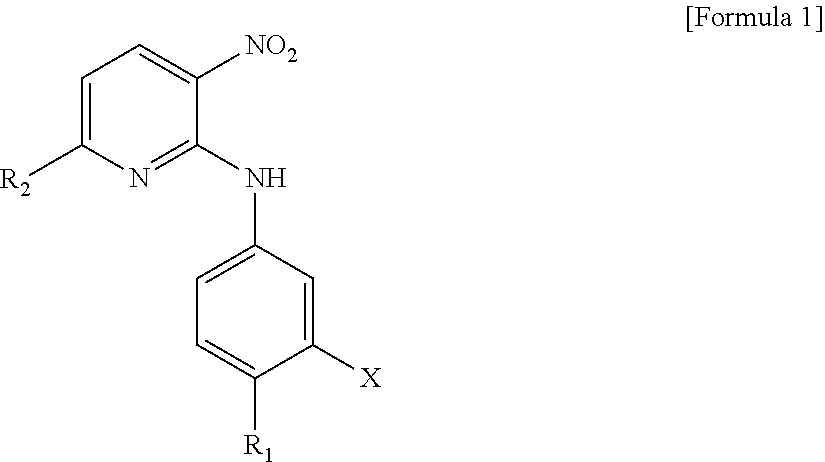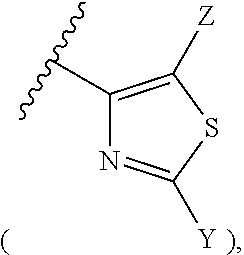Novel 2,6-substituted-3-nitropyridine derivative, method for preparing same, and pharmaceutical composition including same
a technology of nitropyridine and derivative, which is applied in the field of 6-substituted 3nitropyridine derivative compound, a method for preparing the same and a pharmaceutical composition, can solve the problems of reducing bone density or bone mass, brittleness of bone, and reducing bone strength, so as to suppress the formation of osteoclasts, promote the activity of osteoblasts, and effectively facilitate osteogenesis
- Summary
- Abstract
- Description
- Claims
- Application Information
AI Technical Summary
Benefits of technology
Problems solved by technology
Method used
Image
Examples
preparation example 1
Preparation of Formula 4
1-1: Preparation of 2-(4-methylphenylamino)-6-chloro-3-nitropyridine
[0389]To 100 ml of methanol were added 3 g (15.5 mmol) of 2,6-dichloronitropyridine and 2.6 ml (18.7 mmol) of triethylamine and 1.75 g (16.03 mmol) of p-toluidine was then added thereto, followed by reaction at room temperature (20 to 30°) for about 5 hours. After the reaction was complete, 20 ml of water was slowly added thereto, followed by stirring at room temperature for 1 hour. The reactant was filtered, washed with 20 ml of a 4:1 (v / v) solution of methanol and water, and then dried under vacuum at about 40° to afford 2.9 g (yield: 71%) of the desired compound.
[0390]Mass (M+): 264.1
[0391]1H-NMR (DMSO-d6): 2.30(s, 3H), 6.94(d, 2H), 7.18(d, 2H), 7.45(d, 2H), 8.50(d, 1H), 10.07(s, 1H).
1-2: Preparation of 2-(4-methoxyphenylamino)-6-chloro-3-nitropyridine
[0392]To 100 ml of methanol were added 3 g (15.5 mmol) of 2,6-dichloronitropyridine and 2.6 ml (18.7 mmol) of triethylamine and 2 g (16.3 mm...
preparation example 2
Preparation of formula 4 wherein R1 represents thiazole
2-1-1: Preparation of α-bromo-4-nitroacetophenone
[0431]5 g (30.3 mmol) of 4-nitroacetophenone was dissolved in 150 ml of ethyl acetate and 13.5 g (60.6 mmol) of copper (II) bromide was added thereto, followed by stirring at a temperature of 60 to 65° for 8 hours. After the reaction was complete, the reaction liquid was cooled to room temperature and the salt formed during the reaction was filtered off The filtrate was washed three times with a sodium bicarbonate saturated solution. This solution was dried over anhydrous magnesium sulfate, filtered under reduced pressure, distilled under reduced pressure and then dried under vacuum at about 40° to afford 7.3 g (yield: 99%) of the desired compound which was then directly subjected to the subsequent reaction.
[0432]Mass (M+): 245.1
2-1-2: Preparation of 4-(2-methylthiazol-4-yl)nitrobenzene
[0433]To 150 ml of ethanol were added 7.3 g (29.9 mmol) of a-bromo-4-nitroacetophenone synthesi...
preparation example 3
Preparation of formula 4 wherein X represents fluoro
3-1-1: Preparation of (3-fluoro-4-diethylamino)nitrobenzene
[0469]To 50 ml of methanol were added 5 g (31.4 mmol) of 3,4-difluoronitrobenzene, 3.6 ml (40.8 mmol) of triethylamine and 5.3 ml (34.5 mmol) of diethylamine, followed by reaction at a temperature of 50 to 60° for 24 hours. After the reaction was complete, the reaction liquid was cooled to room temperature and 30 ml of water was slowly added dropwise thereto. The resulting solid was filtered, washed with 100 ml of water and then dried under vacuum at about 40° to afford 5.4 g (yield: 81%) of the desired compound.
[0470]Mass (M+): 213.1
[0471]1H-NMR (DMSO-d6): 1.16(t, 6H), 3.45(m, 4H), 6.97(t, 1H), 7.93(t, 2H).
3-1-2: Preparation of (3-fluoro-4-diethylamino)aniline
[0472]To 150 ml of ethyl acetate were sequentially added 5.4 g (25.4 mmol) of (3-fluoro-4-diethylamino)nitrobenzene synthesized in Preparation Example 3-1-1 and 540 mg (10 W %) of Pd / C, followed by reaction in a hydro...
PUM
 Login to View More
Login to View More Abstract
Description
Claims
Application Information
 Login to View More
Login to View More - R&D
- Intellectual Property
- Life Sciences
- Materials
- Tech Scout
- Unparalleled Data Quality
- Higher Quality Content
- 60% Fewer Hallucinations
Browse by: Latest US Patents, China's latest patents, Technical Efficacy Thesaurus, Application Domain, Technology Topic, Popular Technical Reports.
© 2025 PatSnap. All rights reserved.Legal|Privacy policy|Modern Slavery Act Transparency Statement|Sitemap|About US| Contact US: help@patsnap.com



